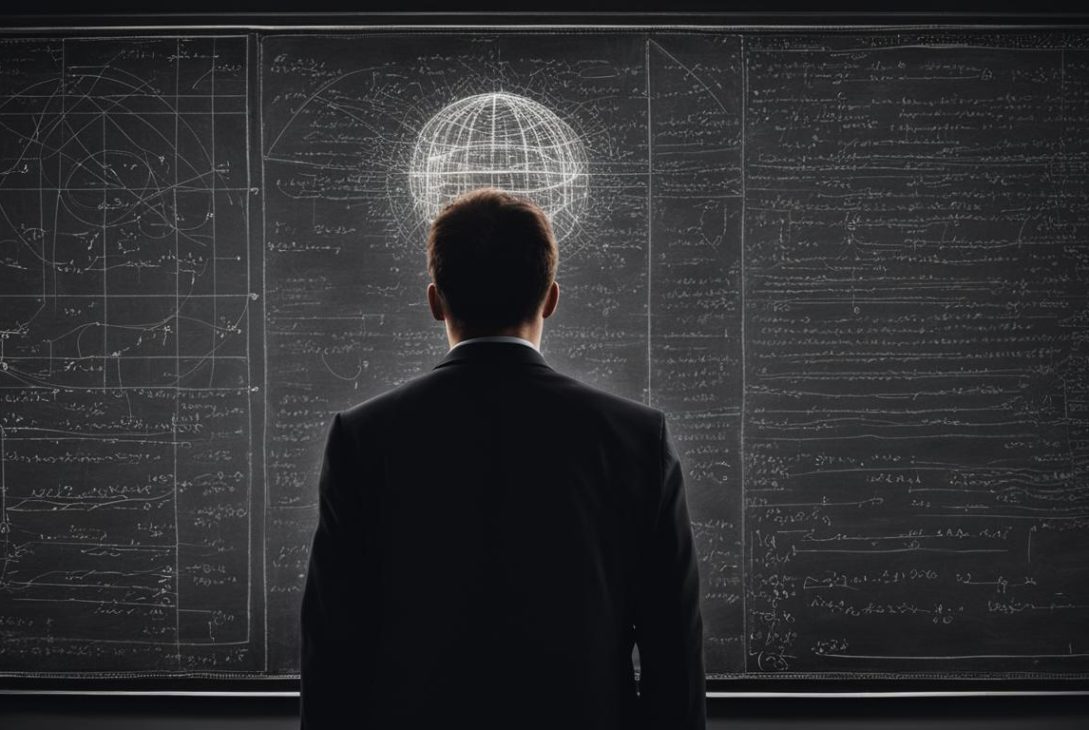Albert Einstein’s theory of relativity is a groundbreaking scientific concept that revolutionized our understanding of the universe. Published by Einstein in 1905, this theory has had a far-reaching impact on the fields of physics, space exploration, and technological advancements.
Relativity theory can be intricate and complex, often involving intricate mathematical equations. However, in this article, we will break down Einstein’s theory of relativity in layman’s terms, making it accessible and easy to comprehend for readers without a background in physics.
Key Takeaways:
- Albert Einstein’s theory of relativity revolutionized our understanding of space, time, and gravity.
- The theory focuses on visualizing concepts rather than complex math equations.
- National Geographic has created an interactive version of one of Einstein’s famous thought experiments to aid in understanding the theory.
- Einstein’s exploration of the theory of relativity began during his teenage years.
- The principle of relativity states that the laws of physics are independent of an observer’s motion.
The Inspiration Behind Einstein’s Theory
Einstein’s exploration of the theory of relativity began in his teenage years when he wondered what it would be like to run alongside a light beam. He later realized that the laws of physics must be the same for everyone, regardless of their motion, and that the speed of light is constant for all observers. This led him to develop the concept of special relativity, which explores the effects of motion on space and time.
The Principle of Relativity
The principle of relativity is a fundamental concept in the field of relativity theory. It states that the laws of physics remain the same regardless of an observer’s motion. In other words, the way we measure motion and velocity between objects is relative to the observer’s frame of reference. This principle, developed by Albert Einstein, challenged the traditional notion of absolute time and space and revolutionized our understanding of the universe.
Einstein’s thought experiments played a crucial role in formulating the principle of relativity. By imagining different scenarios and questioning the nature of simultaneity, he uncovered profound insights about the nature of time and the relativity of motion. This led to the realization that time is not a universal constant, but rather a subjective experience that can vary depending on an observer’s relative motion.
“The principle of relativity declares that the laws of physics must be the same for all observers, regardless of their state of motion.”
To illustrate the principle of relativity, consider the following thought experiment: imagine two spaceships traveling in opposite directions at a significant fraction of the speed of light. From the perspective of each spaceship, the other spaceship would appear to be moving, while their own spaceship would seem stationary. However, according to the principle of relativity, both perspectives are equally valid, as the laws of physics remain unchanged for each observer.
The Concept of Simultaneity
One of the key ideas stemming from the principle of relativity is the concept of simultaneity. We often think of events occurring simultaneously if they happen at the same time according to a single reference frame. However, in relativity theory, simultaneous events can appear differently depending on the observer’s motion. The idea that two events may be simultaneous for one observer but not for another is a direct consequence of the principle of relativity.
The Universal Nature of Relativity
The principle of relativity applies not only to objects in constant motion but also to those undergoing acceleration or deceleration. This means that even in scenarios involving changing velocities or forces, the laws of physics remain constant for all observers. The principle of relativity provides a framework for understanding the relationship between motion, time, and space, and has paved the way for groundbreaking scientific discoveries and advancements in various fields.
| Key Points | Explanation |
|---|---|
| Principle of Relativity | The laws of physics are independent of an observer’s motion. |
| Simultaneity | Events that appear simultaneous in one frame of reference may not be simultaneous in another. |
| Universal Nature | The principle of relativity applies to objects in constant motion as well as those undergoing acceleration or deceleration. |
By embracing the principle of relativity, we gain a deeper understanding of the fundamental nature of our universe. It challenges our intuition and expands our perspective, leading to profound insights into the behavior of matter, energy, and the fabric of spacetime itself.
Next, we will explore the concept of special relativity, where we delve further into the effects of motion on space, time, and the speed of light.
Special Relativity
Special relativity is an extension of the principle of relativity and the constancy of the speed of light. It provides a simplified theory of relativity that explores the intertwined nature of time and space, revealing how they can be perceived differently by observers in relative motion.
One of the key concepts introduced in special relativity is time dilation, which describes how time appears to pass differently for objects in motion compared to those at rest. As an object’s velocity approaches the speed of light, time for that object slows down relative to a stationary observer. This phenomenon has been experimentally confirmed and plays a crucial role in our modern understanding of the universe.
Another important concept in special relativity is length contraction. When an object is in motion, its lengths along the direction of motion appear contracted or shortened compared to its lengths at rest. This contraction is a result of the interplay between motion and the constancy of the speed of light, as observed by different observers.
Effects of Special Relativity:
- Time dilation: Time passes slower for objects in motion relative to stationary observers.
- Length contraction: Objects in motion appear shorter in the direction of motion compared to their rest lengths.
To summarize, special relativity provides a simplified explanation of the basics of relativity theory. It introduces concepts like time dilation and length contraction, shedding light on the effects of motion on the passage of time and the measurement of distances.
General Relativity
In the previous section, we explored the basics of special relativity and how it revolutionized our understanding of motion and time. Now, let’s dive deeper into the fascinating world of general relativity, which builds upon the concepts of special relativity and introduces gravity into the equation.
According to general relativity, gravity is not a force in the traditional sense, but rather a result of the curvature of spacetime caused by mass. This means that objects with mass, such as planets and stars, create a warping effect on the fabric of spacetime, influencing the motion of other objects in their vicinity.
Albert Einstein’s theory of general relativity, published in 1915, provided a groundbreaking explanation for the behavior of gravity in the universe. By introducing the concept of spacetime curvature, Einstein was able to successfully explain phenomena such as the bending of light around massive objects like the Sun.
“The gravitational field has to be thought of as being a curvature of space and time, caused by mass and energy. In the presence of mass and energy, spacetime curves, and objects move along the curvature created by the presence of mass and energy.”
This quote by Einstein encapsulates the essence of general relativity, highlighting the idea that mass and energy determine the curvature of spacetime, which in turn dictates the paths of objects in the universe.
This revolutionary theory opened the doors to a new understanding of the cosmos and has been confirmed through various experiments and observations. For example, the detection of gravitational waves in 2015 provided direct evidence of the existence of gravitational waves, a phenomenon predicted by general relativity over a century ago.
To further illustrate the concept of spacetime curvature, consider the analogy of a rubber sheet. Imagine placing a heavy object on the sheet, causing it to warp or curve. A smaller object placed on the sheet will then follow a curved path around the heavier object, mimicking the behavior of objects in the presence of gravitational fields.
This image illustrates the idea of spacetime curvature, with the heavy object representing a massive celestial body and the curved sheet representing the curvature of spacetime caused by that object’s mass.
General relativity has numerous applications and implications in various fields, including astrophysics, cosmology, and even modern technology. From the study of black holes and the expansion of the universe to the development of accurate satellite navigation systems, the theory of general relativity has transformed our understanding of the universe and paved the way for technological advancements.
In the next section, we will explore the tests and confirmations of relativity that have further solidified Einstein’s theories and shed light on the remarkable accuracy of his predictions.
Tests and Confirmations of Relativity
Over the past century, numerous experiments have been conducted to confirm the validity of both special and general relativity. These experiments have provided evidence that supports and validates Einstein’s groundbreaking theories.
One of the first major tests of general relativity came during a total solar eclipse in 1919. British astronomer Sir Arthur Eddington observed the deflection of starlight by the Sun. This observation confirmed Einstein’s prediction that the mass of the Sun causes light rays to bend as they pass close to it. The deflection of starlight during the eclipse provided strong evidence in favor of general relativity and garnered widespread attention, solidifying Einstein’s reputation as a scientific genius.
In more recent times, technological advancements have enabled scientists to conduct experiments that further validate the principles of relativity. One notable example is the measurement of time dilation, which has been confirmed through experiments involving high-precision atomic clocks. These experiments have demonstrated that time does indeed pass differently for objects in motion relative to each other, confirming a fundamental aspect of special relativity.
Another significant confirmation of relativity came with the discovery of gravitational waves. In 2015, the Laser Interferometer Gravitational-Wave Observatory (LIGO) detected gravitational waves for the first time, providing direct evidence of the warping of spacetime predicted by general relativity. This groundbreaking discovery not only confirmed Einstein’s theory but also opened up a new window for studying the universe.
Overall, these tests and confirmations of relativity have solidified its standing as a valid scientific theory. The experimental evidence gathered over the years has repeatedly upheld the predictions made by Einstein, demonstrating the remarkable accuracy and relevance of relativity in understanding the physical laws that govern our universe.
| Experiment | Description | Confirmation |
|---|---|---|
| Deflection of starlight | Observation of light bending near massive objects | Confirmed prediction of general relativity |
| Time dilation measurement | Experiments with high-precision atomic clocks | Confirmed time dilation predicted by special relativity |
| Gravitational wave detection | Observation of ripples in spacetime caused by massive objects | Confirmed prediction of general relativity |
“The experiments conducted over the years have provided compelling evidence in support of Einstein’s theory of relativity. From the deflection of starlight to the detection of gravitational waves, these tests have confirmed the fundamental principles of relativity and advanced our understanding of the universe.”
Practical Applications of Relativity
In addition to shaping our understanding of space, time, and gravity, relativity theory has also found practical applications in various fields. These applications have had a significant impact on areas such as nuclear power and GPS technology.
Nuclear Power
Einstein’s famous equation E=mc², derived from relativity theory, has been instrumental in the development of nuclear power plants and atomic bombs. The equation reveals the equivalence of mass and energy, highlighting the potential to convert a small amount of mass into a large amount of energy. This principle has allowed scientists to harness the enormous energy released during nuclear reactions, leading to the creation of nuclear power as a viable and efficient energy source.
GPS Technology
Another practical application of relativity theory lies in modern GPS (Global Positioning System) technology. GPS navigation systems rely on precise calculations that take into account both special and general relativity. These calculations correct for the time dilation effects experienced by satellites in orbit and the relative motion between satellites and GPS receivers on Earth. By accounting for these relativistic effects, GPS systems can provide accurate positioning information to millions of users worldwide.

In conclusion, the practical applications of relativity theory extend beyond the realm of abstract concepts and have had a tangible impact on our daily lives. From harnessing nuclear energy to enabling accurate GPS navigation, the practical implications of relativity continue to shape and advance various scientific and technological fields.
The Concepts Underlying Relativity
Understanding the fundamental concepts of relativity theory is crucial for grasping the profound insights it offers into the nature of space, time, and gravity. Let’s explore two key concepts that form the basis of this groundbreaking theory.
1. Relative Motion:
The concept of relative motion is at the core of relativity theory. It states that the motion of an object can only be defined in relation to another object. In other words, there is no absolute frame of reference that determines an object’s motion. Instead, motion is always measured relative to another object or observer.
For example, imagine two cars traveling down a highway. From the perspective of a passenger in one car, it may appear as though the other car is moving backward. However, from the perspective of a bystander on the side of the road, both cars are in motion. The perception of motion depends on the observer’s frame of reference.
2. Constant Speed of Light:
Another fundamental concept of relativity theory is the constant speed of light. Regardless of the observer’s motion, the speed of light in a vacuum always remains the same, approximately 299,792,458 meters per second. This principle, established by Einstein, has profound implications for our understanding of the universe.
Imagine two spaceships moving at different speeds. If both spaceships measure the speed of light, they will obtain the same value, despite their relative motion. This constant speed of light challenges our intuitive understanding of how velocities add up. Unlike everyday objects, which can move faster or slower depending on the observer’s frame of reference, the speed of light is an absolute constant.
In summary, the concepts of relative motion and the constant speed of light are fundamental to relativity theory. These concepts provide the foundation for exploring the effects of motion on space, time, and gravity.
| Key Concepts | Description |
|---|---|
| Relative Motion | The motion of an object can only be defined in relation to another object or observer. |
| Constant Speed of Light | The speed of light in a vacuum is always the same, regardless of the observer’s motion. |
The Nature of Time in Relativity
Relativity theory challenges our traditional understanding of time as a universal constant. According to Einstein’s theories, time can be influenced by factors such as motion and gravity.
Time dilation, where time appears to pass differently for observers in relative motion, is a key concept in relativity. The stretching and warping of time is influenced by the speed at which an object is moving and the strength of gravity in its surroundings.
As objects accelerate or move at high speeds, time for those objects appears to slow down compared to a stationary observer. This means that time is not fixed but rather a flexible concept that can vary depending on the observer’s frame of reference.
The effects of time dilation have been observed and measured in numerous experiments, confirming the validity of Einstein’s theories. For example, studies using atomic clocks on airplanes or satellites have shown that time passes slightly slower for objects in motion compared to stationary clocks on Earth.
“The faster an object moves or the stronger the gravitational field it experiences, the more pronounced the time dilation effects become.”
This understanding of time in relativity theory has profound implications for our perception of the universe. It challenges our intuitive understanding of time as a steady and unchanging flow, instead revealing it to be malleable and subject to the influence of various factors.

The Speed of Light in Relativity
In the realm of relativity, the speed of light holds a special place. It is an unchanging constant, independent of the motion of observers and light-emitting objects. No matter how fast an observer is traveling or how fast a light source is moving, the speed of light remains constant. This fundamental principle has profound implications and leads to intriguing phenomena within the realm of relativity.
One of the consequences of the constant speed of light is time dilation. According to relativity, time is not universal, but rather depends on the relative motion between observers. As an observer approaches the speed of light, time slows down relative to a stationary observer. This effect has been observed and confirmed through various experiments.
Another intriguing phenomenon related to the speed of light is length contraction. When an object moves at a significant fraction of the speed of light, it appears shorter in the direction of motion compared to a stationary observer. This contraction of length is a direct result of the constant speed of light in relativity.
“The constancy of the speed of light in relativity is a fundamental tenet that challenges our intuition about how the world works. It forces us to reevaluate our understanding of time, space, and motion.”
The speed of light in relativity profoundly alters our understanding of the universe and presents intriguing puzzles for scientists to solve. To visualize the effects of the constant speed of light, consider the twin paradox. In this thought experiment, one twin remains on Earth while the other travels near the speed of light. When the traveling twin returns, they have aged less relative to the twin who stayed on Earth.
The universality of the speed of light allows us to explore the depths of the cosmos and unravel the mysteries of the universe. It shapes our understanding of the fabric of space and time, and provides essential insights into the nature of reality itself.
| Phenomena | Description |
|---|---|
| Time Dilation | Time slows down for objects in motion relative to stationary observers. |
| Length Contraction | Objects appear shorter in the direction of motion at high velocities. |
| Twin Paradox | One twin ages less than the other due to significant differences in relative motion. |
The Equation E=mc²
The equation E=mc² is one of the most famous equations in physics, derived from Albert Einstein’s theory of relativity. It represents the energy-mass equivalence, revealing the profound relationship between energy and mass. Let’s break it down:
E: Energy
m: Mass
c: Speed of light
The equation states that the energy of an object is equal to its mass multiplied by the speed of light squared. This means that even a small amount of mass contains a tremendous amount of energy. The speed of light, denoted by c, is approximately 299,792,458 meters per second in a vacuum.
The equation E=mc² captures the idea that mass and energy can be converted into one another. It revolutionized our understanding of the universe and has profound implications in various fields of science.
To put it into perspective, let’s consider an example. If we were to convert just one gram of mass into energy using the equation E=mc², we would obtain an amount of energy equal to:
E = (m) * (c)²
E = (1 gram) * (299,792,458 m/s)²
Plugging in the numbers, we find that just one gram of mass is equivalent to 89,875,517,873,681 joules of energy. This is an astronomical amount of energy released from such a small mass!
This equation has had a profound impact on our understanding of the physical world and has been used in various scientific and technological advancements. From nuclear power to space exploration, the energy-mass equivalence plays a crucial role.
Applications of the Equation E=mc²
The concept of energy-mass equivalence described by the equation E=mc² has led to significant practical applications:
| Application | Description |
|---|---|
| Nuclear Power | The equation forms the basis for understanding nuclear reactions, where the conversion of a small amount of mass into energy can generate vast amounts of power. Nuclear power plants harness this energy release to produce electricity. |
| Atomic Bombs | The equation E=mc²’s insight into the energy released from mass conversion has played a role in the development of atomic bombs, where a small amount of mass is converted into a devastating explosion. |
| Particle Physics | E=mc² is used in particle accelerators to study the fundamental building blocks of matter. It provides a framework for understanding the interplay between mass and energy in particle interactions. |
| Solar Energy | The equation is relevant to solar energy, as the sun converts mass into energy through nuclear fusion reactions. Understanding this process helps scientists and engineers develop more efficient solar energy technologies. |
These are just a few examples of how the equation E=mc² has practical implications beyond the theoretical realm. The energy-mass equivalence has revolutionized our understanding of the universe and continues to shape scientific discoveries and technological advancements.
Conclusion
Einstein’s theory of relativity has transformed our understanding of the fundamental workings of the universe. By challenging traditional notions of space, time, and gravity, this groundbreaking theory introduced concepts that have become essential in the fields of physics and technological advancements.
Through rigorous experimentation and observation, the theory of relativity has been validated time and again, providing strong evidence for its validity. This scientific validation, coupled with the practical applications of relativity in modern life, has cemented its status as a cornerstone of scientific inquiry.
Today, we see the impact of relativity theory in various aspects of our daily lives. From the development of nuclear power plants and atomic bombs, which rely on the conversion of mass into energy based on the famous equation E=mc², to the precise positioning information provided by GPS navigation systems, which account for the effects of relativity on time and space, relativity theory continues to shape our world.
In conclusion, Einstein’s theory of relativity has revolutionized our understanding of the universe and continues to inspire new discoveries and technological advancements. Its profound impact on science and society is a testament to the power of human curiosity and the potential of scientific exploration.
FAQ
What is Einstein’s theory of relativity?
Einstein’s theory of relativity, published in 1905, is a scientific theory that revolutionized our understanding of space, time, and gravity. It describes how the laws of physics are the same for all observers, regardless of their motion, and how the speed of light is constant for everyone.
How can I understand relativity theory?
Relativity theory can be understood by visualizing concepts rather than focusing on complex math equations. It helps to think of motion, time, and space as relative to each other, with the speed of light being a constant and fundamental principle of the theory.
What is the principle of relativity?
The principle of relativity states that the laws of physics are independent of an observer’s motion. This means that measurements of motion and velocity between objects must be relative to each other.
What is special relativity?
Special relativity is a branch of relativity theory that explores the effects of motion on space and time. It builds upon the principle of relativity and the constancy of the speed of light, introducing concepts such as time dilation and length contraction.
What is general relativity?
General relativity expands upon the concepts of special relativity by incorporating gravity. It explains that gravity is not a force but rather a curvature of spacetime caused by mass. Objects with mass create a warping effect on the fabric of spacetime, affecting the motion of other objects in their vicinity.
How has relativity theory been tested and confirmed?
Relativity theory has been validated through numerous experiments. The deflection of starlight by the Sun during a total solar eclipse in 1919 provided the first major test of general relativity. Modern experiments, such as the measurement of time dilation and the discovery of gravitational waves, have further supported Einstein’s theories.
What are the practical applications of relativity?
Relativity theory has had significant implications for various fields. The understanding that mass can be converted into energy has been crucial in the development of nuclear power plants and atomic bombs. Additionally, GPS navigation systems rely on calculations that take into account both special and general relativity to provide accurate positioning information.
What are the fundamental concepts of relativity theory?
The fundamental concepts of relativity theory include the concept of relative motion, where the motion of an object can only be defined in relation to another object. The constant speed of light is also a foundational principle, meaning that the speed of light is always the same regardless of the observer’s motion.
How does relativity theory affect our understanding of time?
Relativity theory challenges the traditional notion of time as a universal constant. According to Einstein’s theories, time can be influenced by factors like motion and gravity. Time dilation, where time appears to pass differently for observers in relative motion, is a key concept in relativity.
What is the speed of light in relativity?
The speed of light is a fundamental constant in relativity, remaining the same for all observers regardless of their motion. This means that no matter how fast an object or a light-emitting object is traveling, the speed of light always measures the same.
What is the equation E=mc²?
The equation E=mc², derived from Einstein’s theory of relativity, describes the relationship between energy and mass. It states that energy is equal to the mass of an object multiplied by the speed of light squared. This equation reveals that mass and energy are interchangeable, with even a small amount of mass being equivalent to a large amount of energy.
What is the conclusion on relativity theory?
Relativity theory has revolutionized our understanding of space, time, and gravity. It has been validated through numerous experiments and has practical applications in various aspects of modern life. Relativity theory continues to be a cornerstone of scientific inquiry and our understanding of the universe.
Source Links
- https://www.nbcnews.com/mach/science/what-relativity-einstein-s-mind-bending-theory-explained-ncna865496
- https://www.nationalgeographic.com/science/article/einstein-relativity-thought-experiment-train-lightning-genius
- https://medium.com/amalgamate/a-simple-explanation-of-einsteins-theory-of-relativity-af200fd0eb19
Relativity Simplified Relativity Simplified: Einstein’s Theory in Layman’s Terms
Last modified: December 27, 2023





